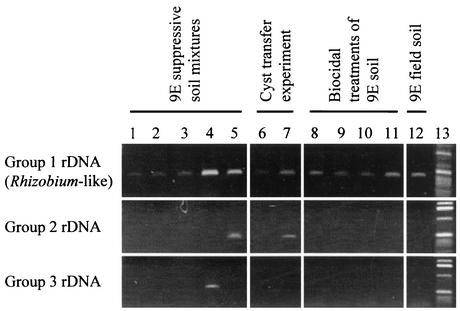FIG. 2.
Amplification of bacterial rDNA associated with H. schachtii cysts by using group-selective PCR. Amplification reactions were performed using PCR primers selective for the three bacterial groups that were most abundant in cysts from the soil treatments exhibiting the most H. schachtii suppressiveness (Table 4). PCR experiments were performed on DNA from H. schachtii cysts from five 9E soil mixtures (Table 1) (lanes 1 to 5), the cyst transfer experiment (lanes 6 to 7), three biocidal treatments of 9E soil (Table 2) (lanes 8 to 11), and the 9E field soil (lane 12). Lanes: 1, 0% 9E soil, 2, 0.1% 9E soil; 3, 1% 9E soil; 4, 10% 9E soil; 5, 100% 9E soil; 6, methyl iodide-fumigated 9E soil; 7, untreated 9E soil; 8, fludioxonil-treated 9E soil; 9, formaldehyde-treated 9E soil; 10, methyl iodide-treated 9E soil; 11, untreated 9E soil; 12, 9E field soil; 13, 1-kb DNA ladder (Life Technologies). Each percentage indicates the proportion of suppressive soil.

